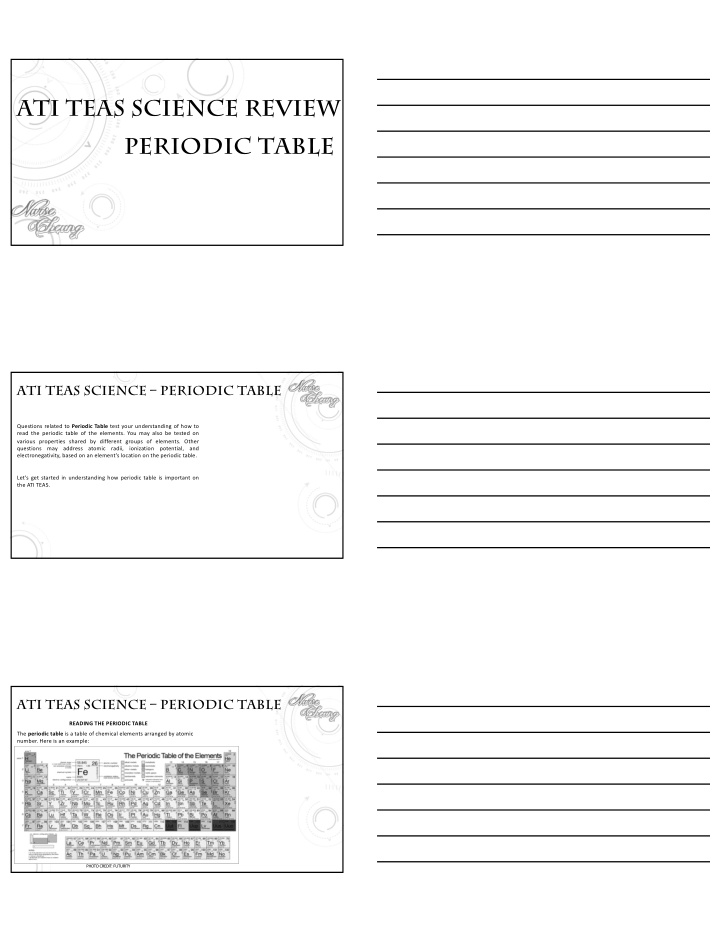



ATI TEAS SCIENCE REVIEW PERIODIC TABLE ATI TEAS SCIENCE – PERIODIC TABLE Questions related to Periodic Table test your understanding of how to read the periodic table of the elements. You may also be tested on various properties shared by different groups of elements. Other questions may address atomic radii, ionization potential, and electronegativity, based on an element’s location on the periodic table. Let’s get started in understanding how periodic table is important on the ATI TEAS. ATI TEAS SCIENCE – PERIODIC TABLE READING THE PERIODIC TABLE The periodic table is a table of chemical elements arranged by atomic number. Here is an example: PHOTO CREDIT: FUTURITY
ATI TEAS SCIENCE – PERIODIC TABLE READING THE PERIODIC TABLE The elements on the periodic table are listed in order of their atomic number . Some periodic tables provide the atomic mass of the element as well: From the periodic table, by reading the atomic number, you can determine the number of protons and electrons in a neutral atom of an element. The number of neutrons can also be determined if the mass number of the atom is known. ATI TEAS SCIENCE – PERIODIC TABLE UNDERSTANDING PERIODS AND GROUPS Groups in the periodic table are organized vertically down Elements of the periodic table are arranged in periods the table in columns. Groups may also be referred to as and in groups. Periods of the periodic table are organized families. In the table shown, the shaded column represents horizontally across the table in rows. In the table show, a group: the shaded row represents a period: PHOTO CREDIT: WIZER PHOTO CREDIT: WIZER ATI TEAS SCIENCE – PERIODIC TABLE UNDERSTANDING PERIODS AND GROUPS Elements in different groups share certain properties. The alkali metals in group 1 are shiny, soft, and highly reactive. The alkaline earth metals in group 2 are fairly soft and fairly reactive. The transition metals in groups 3 to 12 are hard and have low to negligible reactivity. The halogens in group 17 are extremely reactive, whereas the noble gases in group 18 are extremely stable. Metals overall tend to be malleable and highly conductive of heat and electricity, whereas nonmetals break easily and are generally poor conductors. Metalloids , such as boron, silicon, and germanium, have properties between those of metals and nonmetals. PHOTO CREDIT: FUTURITY
ATI TEAS SCIENCE – PERIODIC TABLE UNDERSTANDING ATOMIC RADII The atomic radius of an atom is the measure of the distance from the center of the atom to its outermost orbital shell. Atoms with greater numbers of orbital shells have larger atomic radii because the outermost electrons are father away from the nucleus. The length of the atomic radii decreases as you move from the left to right across a period (row) of the table. The length of the atomic radii increases as you move down a group (column of the table). PHOTO CREDIT: SOCRATIC ATI TEAS SCIENCE – PERIODIC TABLE UNDERSTANDING IONIZATION POTENTIAL AND ELECTRONEGATIVITY The term ionization energy is used to refer to the amount of energy required for the removal of one electron from an atom. The ionization energy of an atom increases as the atomic radius of the atom decreases. This means that ionization energy increases as you move from left to right across a period (row) of the table. It also decreases as you move down a group (column) of the table. The term electronegativity is used to refer to the tendency of an atom to want to bond with other atoms by taking electrons from those atoms. Like ionization energy, the electronegativity of an atom increases as the atomic radius of the atom decreases. This means that electronegativity increases as you move from left to right across a period (row) as atomic radius decreases, and it decreases as you move down a group (column) of a table as the atomic radius increases. PHOTO CREDIT: THOUGHT CO ATI TEAS SCIENCE – PERIODIC TABLE UNDERSTANDING ORBITALS The periodic table can also show the orbitals for the elements. An orbital is an area around the nucleus of a cell where electrons can be located. There are four types of orbitals. • An s orbital is the lowest level of energy and forms a symmetrical sphere around the nucleus. It can have a maximum of 2 electrons. • A p orbital is like an hourglass shape with the nucleus at the center. The p orbital has a maximum of 6 electrons. • D orbitals are more complex, but most look like four pear shapes connected by the nucleus at the center. The d orbital has a maximum of 18 electrons. • F orbitals are even more complex and are very difficult to visualize. The f orbital has a maximum of 32 electrons.
ATI TEAS SCIENCE – PERIODIC TABLE UNDERSTANDING ORBITALS As the period numbers on the periodic table increase, the number of orbitals available also increases. Period 1 has only one orbital, s , with a maximum of 2 electrons. Period 2 elements have both an s orbital and a p orbital. Period 3 can have s , p , and d orbitals. Period 4 can have s , p , d , and f orbitals.
Recommend
More recommend